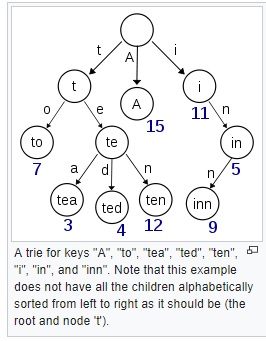Trie Class Data Structure in Python
- 时间:2020-09-09 13:16:32
- 分类:网络文摘
- 阅读:120 次
Implement a trie with insert, search, and startsWith methods.
Example:
Trie trie = new Trie(); trie.insert("apple"); trie.search("apple"); // returns true trie.search("app"); // returns false trie.startsWith("app"); // returns true trie.insert("app"); trie.search("app"); // returns trueNote:
You may assume that all inputs are consist of lowercase letters a-z.
All inputs are guaranteed to be non-empty strings.Your Trie object will be instantiated and called as such:
Implement a Trie in Python
The Trie is a useful data structure that can be used to store words so that we can check if any given word (or prefix) is in the list in linear time O(N).

trie-example
It is simple to implement a Trie class in Python. For each Trie Node, we need to tell if is a leaf node (indicates a word), and the children nodes. Then we start from the begining of the word, follow the path in the Trie tree, until the end, or the corresponding child is not existent in the Trie.
The startsWith, search and insert are of similar implementations with slight difference.
1 2 3 4 5 6 7 8 9 10 11 12 13 14 15 16 17 18 19 20 21 22 23 24 25 26 27 28 29 30 31 32 33 34 35 36 37 38 39 40 41 42 43 44 45 46 47 48 49 50 | class Trie(object): def __init__(self): """ Initialize your data structure here. """ self.nodes = {} self.leaf = False def insert(self, word): """ Inserts a word into the trie. :type word: str :rtype: None """ root = self for i in word: if i in root.nodes: root = root.nodes[i] else: root.nodes[i] = Trie() root = root.nodes[i] root.leaf = True def search(self, word): """ Returns if the word is in the trie. :type word: str :rtype: bool """ root = self for i in word: if i in root.nodes: root = root.nodes[i] else: return False return root.leaf def startsWith(self, prefix): """ Returns if there is any word in the trie that starts with the given prefix. :type prefix: str :rtype: bool """ root = self for i in prefix: if i in root.nodes: root = root.nodes[i] else: return False return True |
class Trie(object):
def __init__(self):
"""
Initialize your data structure here.
"""
self.nodes = {}
self.leaf = False
def insert(self, word):
"""
Inserts a word into the trie.
:type word: str
:rtype: None
"""
root = self
for i in word:
if i in root.nodes:
root = root.nodes[i]
else:
root.nodes[i] = Trie()
root = root.nodes[i]
root.leaf = True
def search(self, word):
"""
Returns if the word is in the trie.
:type word: str
:rtype: bool
"""
root = self
for i in word:
if i in root.nodes:
root = root.nodes[i]
else:
return False
return root.leaf
def startsWith(self, prefix):
"""
Returns if there is any word in the trie that starts with the given prefix.
:type prefix: str
:rtype: bool
"""
root = self
for i in prefix:
if i in root.nodes:
root = root.nodes[i]
else:
return False
return True The space requirement for Trie is O(NM) where N is the number of words, and M is the average length of each word. The runtime complexity for searching a word in the Trie is O(M).
The C++ Implementation of Trie can be found here: The Beginners’ Guide to Trie: How to Use the Trie in C++?
–EOF (The Ultimate Computing & Technology Blog) —
推荐阅读:How to Compute the Day of the Week using C++? Counting Substrings with Only One Distinct Letter with Different Ukranian Authorities Prevent Security Blogger From Getting Kidna 5 Instagram Tools to Help You Get More Blog Visitors 6 SEO Analysis Tools Every SEO Needs to Know For 2017 Top Tools to Create and Sell Content Mauritania Clerics Call For ‘Apostasy’ Blogger To Be Killed Automating WordPress Website Marketing With GetResponse Travel Blogger Teaches People ‘How To Move To New Zealand’ After 50 Content Marketing Ideas to Go From Rookie to Super Hero [Info
- 评论列表
-
- 添加评论